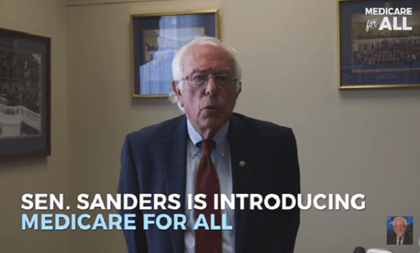Thirty trillion dollars, even in U.S. budget terms, is a lot of money.
That’s the rough estimate from some analysts of the 10-year cost of Sen. Bernie Sanders’ “Medicare for All” plan, just one of many expensive social programs that some of the 21 Democrats seeking to replace President Donald Trump have proposed.
(Related: View: Medicare for All Would Be Expensive for All)
To pay for those programs, the candidates have focused on taxing the rich. But many of the plans they’ve put on the table would require across-the-board tax increases that would hit middle-earners as well as the wealthy, public policy analysts say. None more than Medicare For All.
Raising the more than $30 trillion needed to fund Sanders’s health plan over a decade would require doubling all personal and corporate income taxes or tripling payroll taxes, which are split between employees and employers, said Marc Goldwein, a senior vice president at the non-partisan Committee for a Responsible Federal Budget.
“There is a lot of money out there, but there isn’t $30 trillion sitting around from high earners,” he said. “It just doesn’t exist.”
Sanders has backed the concept for years, and when he proposed similar legislation in 2013 it attracted no co-sponsors. But when he offered his Medicare for All legislation in April, 14 other Democratic senators signed on, including Kamala Harris, Cory Booker, Kirsten Gillibrand and Elizabeth Warren, four of his rivals for the Democratic nomination.
Price Tag
Still, many Democrats have balked at the price tag for Sanders’ proposal. The $3 trillion estimate annual cost for Sanders’ plan compares with the $582 billion cost for Medicare in fiscal 2018, and would be a substantial addition to the current federal budget of about $4.4 trillion.
Other Democrats, while generally favoring a way to provide universal health care coverage, are pursuing scaled-back versions, such as a “public option” that would allow people to buy into Medicare or Medicaid, but not do away with private insurance. Harris, Booker and Gillibrand also are co-sponsoring one of the alternative plans.
Warren has also touted public relief of college debt — $1.25 trillion— and subsidizing child care — $700 billion, while former Rep. Beto O’Rourke has proposed creating new programs to combat climate change for $5 trillion — all while promising to lower middle-class taxes.
Tax Increases
Democrats have defended the tax increases needed to pay for their plans by promising the brunt would be borne by top earners or that they’ll end up paying less overall than they do for those services currently.
“You’re going to pay more in taxes,” Sanders said at a CNN town hall last month. “But at the end of the day, the overwhelming majority of people are going to end up paying less for health care because they’re not paying premiums, co-payments and deductibles.”
Even though the government would have to increase payroll tax rates from the current 15.3% to about 45% to fund Medicare-for-All, the average family would see their tax burden increase about 2% to 3%, said Ernie Tedeschi, a managing director for research firm Evercore ISI. Payroll tax bills are split between employees and employers.









 May 09, 2019 at 06:59 PM
May 09, 2019 at 06:59 PM











